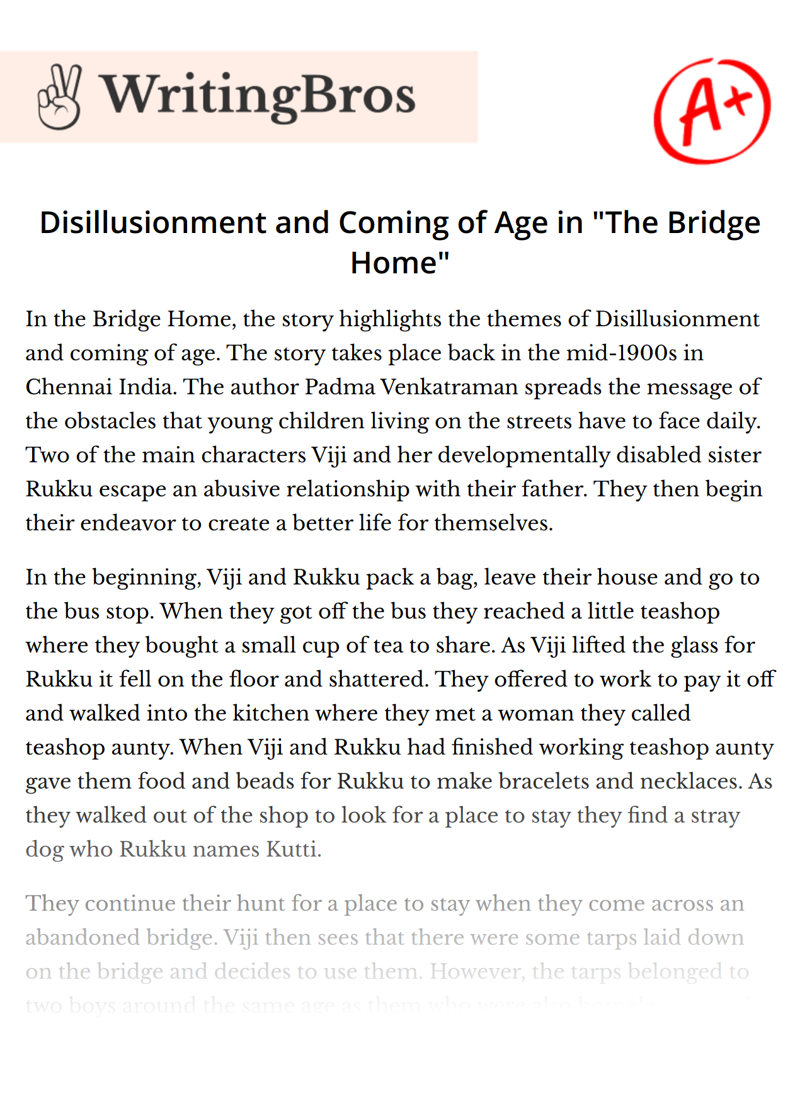Disillusionment and Coming of Age in "The Bridge Home"

In the Bridge Home, the story highlights the themes of Disillusionment and coming of age. The story takes place back in the mid-1900s in Chennai India. The author Padma Venkatraman spreads the message of the obstacles that young children living on the streets have to face daily. Two of the main characters Viji and her developmentally disabled sister Rukku escape an abusive relationship with their father. They then begin their endeavor to create a better life for themselves.
In the beginning, Viji and Rukku pack a bag, leave their house and go to the bus stop. When they got off the bus they reached a little teashop where they bought a small cup of tea to share. As Viji lifted the glass for Rukku it fell on the floor and shattered. They offered to work to pay it off and walked into the kitchen where they met a woman they called teashop aunty. When Viji and Rukku had finished working teashop aunty gave them food and beads for Rukku to make bracelets and necklaces. As they walked out of the shop to look for a place to stay they find a stray dog who Rukku names Kutti.
They continue their hunt for a place to stay when they come across an abandoned bridge. Viji then sees that there were some tarps laid down on the bridge and decides to use them. However, the tarps belonged to two boys around the same age as them who were also homeless named Arul and Muthu. As a result, they slept on the floor of the bridge. The next morning they tried to find a place to work but nobody would accept them so they went to a landfill to collect plastic bottles and other items to sell to the garbage man. As they worked hard to earn money Rukku sold her necklaces and earned a significant amount of money. They use the money to buy mats, pillows, and food.
The next day as they returned to collecting bottles the garbage man discovers where they had been living. This leads to the climax where the garbage man locates the bridge which left the group of kids no other choice but to run away from what they had once called home. Leaving all their stuff behind they ran so far and found themselves in a graveyard. They spent the night in the graveyard and when they woke they went back to the bridge to find all their stuff broken or ripped into pieces. Arul tried to spread hope and took everyone to a church to pray though Viji, Rukku, and Muthu weren’t very religious. As they were walking out they met a woman named Celina Aunty who provided a school and home for children. Viji took her card and thought this was a great idea but Muthu didn’t agree because of the previous experience he had with opportunities like this. However, the rainy season was coming in strong and Rukku and Muthu started getting horribly sick. Viji and Arul did as much as they could but they nothing they did would work.
Finally, Viji and Arul decide to take Muthu and Rukku to Celina Aunty who gives immediate care to them and takes them all to the hospital. They were treated as best as they could be, but only Muthu could be saved. Viji begins to feel lost and loses all hope. However, Celina Aunty takes her to a school for children with disabilities where she immediately connects with one of the children there. Viji is then reminded of her dreams to become a teacher and starts working as hard as she can in her school. Celina Aunty offers for her to go to a boarding school that would help her achieve her dreams. She wasn’t sure at first because she didn’t want to leave Arul and Muthu, but they both inspired her to go, so she told Celina Aunty she would go and finally understood that though the world can be a difficult place that it was all worth it.
In my opinion, this book was uplifting and eye-opening. It showed me that though there will be difficult obstacles to overcome I should always try my best to work through them. It also reminded me that there are children in the world who still struggle with homelessness today. Also, I feel that this book should be read by everyone and would highly recommend it to others.
Cite this Essay
To export a reference to this article please select a referencing style below

